What do you do when the game is tied and the clock is running down?
Lexus has done literally that with a long version of its popular RX350 crossover SUV – which is the grandaddy of all crossover SUVs.
When it came out back in ’97 as a new ’98 model no one else had anything like it. There were sedans, coupes, wagons. and trucks and SUVs.
The idea of crossing over was new.
Now, it’s not. Everyone has a crossover.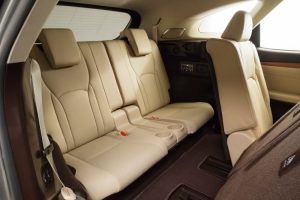
Which is one reason why Lexus decided to come up with a different take on the now well-worn idea.
It is the RX350L – “L” for longer. To make room for three rows instead of just two. Which gives the RX one more row than two-row-only row only rivals like the Cadillac XT5 and Lincoln MKC and catches up with rivals like the Acura MDX and Infiniti QX60 which already offer that – plus something else.
WHAT IT IS
The Lexus RX350 is the original crossover SUV – the one which started it all, almost exactly 20 years ago.
Crossovers are taken for granted today. In 1998, the idea was radical. Would it sell? It did. So much so that everyone else jumped on the bandwagon.
But while the RX has many rivals now – including the MDX and the XT5 as well as the QX50 and the BMW X5 and the Audi Q5 and the Jaguar F-Pace – to name just some of them – none of them are as comfortably familiar as the RX, which has accumulated generations of faithful buyers.
Who now have a new RX iteration to tempt them.
Base price is $43,470 for the regular length, five-passenger (two rows of seats) RX with front-wheel-drive; adding the optional AWD system bumps the MSRP up to $44,870. There is also a more aggressive looking version of the RX350 – the RX350 F Sport. It stickers for $49,120 in FWD form and $50,520 with the optional AWD system.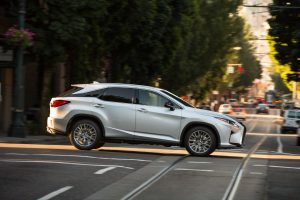
The RX350L – with third row seating and room for seven – stickers for $47,670 to start with FWD and $49,070 with AWD.
The F Sport package is not offered with the longer L version of the RX350, but you can buy a luxury-laden . . . Lux version.
It lists for $52,685 with FWD and $54,085 with AWD.
WHAT’S NEW
In addition to the extended length RX350L, all RXs now come standard with a ten-year subscription to Lexus’ Enform concierge/roadsie assistance service.
Extra seats – without being extra large. Three-row RX is only about four inches longer than two-row RX (and not nearly as long as some of its Behemothian rivals).
If you don’t need the third row, you don’t have to buy the additional inches of RX. Some rivals – like the Acura MDX – offer an available third row but even if you skip it, you still have to buy the one-size-fits-all length MDX.
Still the most blue chip luxury crossover. Historically low depreciation rates – excellent track record for being reliable and long-lived.
Third row comes at a cost . . . of cargo capacity behind third row, which is about half that of the two-row RX (7.5 cubic feet vs. 18.4 cubic feet).
F-Sport performance upgrades not available with third row RX.
Rivals like the MDX have higher max tow ratings (5,000 lbs. vs. 3,500 lbs. for the RX).
UNDER THE HOOD
Bucking trends, the RX – regular and long length – still comes standard with a V6. And without a turbo. The trend is away from larger engines without turbos to smaller engines with them – in order to make up for their being small.
It’s a contortion made necessary by government arm-twisting. The smaller/turbo’d engines have the potential to burn a bit less gas, which is only important because the government continues to demand that new vehicles burn less – even though buyers don’t seem to share this desire.
Buyers seem to prefer power – and performance. Which sets up a fail scenario.
The smaller and turbo’d to-make-up-for-it fours might use a bit less fuel than a V6 . . . if driven hypermiling Prius style; keeping your foot off the accelerator to keep the engine off boost.
But people buying Lexus RXs – and other such vehicles – didn’t buy a Prius for a reason. They want power and performance. Which the turbo makes – at the cost of mileage.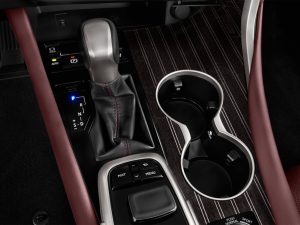
A V6 uses gas, too – but without the strain or the complexity. It is very likely that a V6 like the RX’s will live longer – and give you less trouble – than a turbo’d four.
It’s part of the reason why the RX is blue chip.
Another part of the reason is that the V6 – 3.5 liters – is the same basic V6 Toyota/Lexus has been using for years in other blue chip models like the Camry and Avalon/ES 350. It has a track record for being hard to hurt and rarely needing more than the usual routine fluid/filter changes.
In the RX350, it produces 295 hp – 290 in the RX 350L, apparently because of a slightly more restrictive exhaust in the latter.
Both versions are paired with an eight-speed automatic and either FWD or AWD, the latter available with a driver-selectable differential lock feature that maintains a 50-50 power split for maximum traction on slippery surfaces.
The AWD system can also automatically route 100 percent of the engine’s power to either the front or the rear wheels. This is the hot ticket for acceleration on dry pavement and also helpful during high-speed cornering.
Zero to 60 happens in just over 7 seconds.
Gas mileage is about the same with either the FWD or the AWD version – 19 city, 26 highway and 20 city, 27 highway, respectively.
The V6 is also a regular unleaded engine. It does not require premium, nor does Lexus recommend it. Many of the new turbo-tweaked fours do recommend it. Some require it.
The V6s also has a fail-safe system for the direct-injection fuel-delivery system – a separate port-fuel injection circuit. DI engines which don’t have this fail-safe are prone to carbon crud building up on the backsides of intake valves, which would normally be kept clean by the solvent action of gasoline washing over them before it enters the cylinder to be burned.
In DI engines, the fuel is injected directly into the cylinders – and the valves run dry (so to speak). Lexus added the PFI circuit to address this inherent problem with DI – and it ought to assure that the 3.5 liter V6 remains blue chip.
What makes the RX drive differently? It’s more a matter of what you can see that makes driving it different.
Like, the road.
The dashboard is lower than typical, which affords a much better view ahead. You don’t feel all hunkered down, Batmobile-style.
You’re also up higher – which is true in crossovers generally, but a bit more so in the RX – which rides 8.2 inches off the pavement (about an inch higher than rivals like the MDX). This is another situational awareness edge, since you can see over things which would otherwise obscure your view ahead. The generous clearance will also be helpful on snow days. As valuable as AWD can be when the flakes begin to fall, ground clearance matters at least as much when they begin to accumulate.
It’s worth mentioning here that the FWD version of the RX has the same 8.2 inches of clearance as the AWD-equipped version.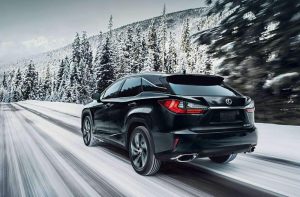
To get more clearance, you’ll have to go Subaru – and while they make some excellent crossovers (including a three-row crossover, the 2019 Ascent) they are not Lexus crossovers. Which is more than just a badge thing.
It’s also an engine thing.
Remember: The Lexus comes with that big V6, standard. Big – in comparison with the small fours that are not only standard in non-luxury-badged crossovers like the Ascent but also the only engines available in models like the Ascent.
Just as V8s have been replaced by V6s in most luxury cars – and become for the most part the powerplants of ultra-luxury cars only – so also V6s are now pretty much absent from the ranks of bread-and-butter crossovers. This endows crossovers like the Lexus RX with cachet as well as other things.
For openers, more power – and much better performance. The RX’s V6 makes almost 300 hp – nearly 40 more horsepower than the Ascent’s turbo four and the Ascent’s turbo four is among the more powerful turbo fours in the bread and butter crossover class. And because it has more power, the Lexus is quicker – and that is a tangible metric of luxury. It is pleasant to be able to put distance between yourself and the masses.
To be fair, other luxury crossovers like the Acura MDX and the Cadillac XT5 also come wth powerful sixes. In the case of the Cadillac, a more powerful six: 3.6 liters and 310 hp. But the Caddy doesn’t offer the third row.
The MDX does, but it comes with a catch.
Both versions of the RX ride on the same 109.8 inch wheelbase but the three-row RXL is 4.4 inches longer overall (196.9 inches vs. 192.5) to accommodate the extra row. It’s a stretch, but not a noticeable one. Unless you park a two-row RX350 next to an RX350L, you’d be hard-pressed to tell. The proportions of the L aren’t awkward – as they often are when a vehicle is extended after the fact.
But the more important thing here is that if you don’t need the extra row, you don’t have to buy the extra length.
Some rivals – the MDX, for instance – offer a third row but don’t offer the less-long crossover, if you don’t need the third row. Two or three rows, the MDX is the same 196.2 inches long.
The Cadillac XT5 is less long than either – 189.5 inches – and manages to have both a roomier second row (39.5 inches of legroom vs. 38 in the RX and just 36.6 in the MDX) as well as much more cargo room behind its second row (30 cubic feet vs. 18.4 for the Lexus and 14.9 for the Acura) but there’s no third row option, which crosses it off the list if you need that one-more-row.
The third row in the RXL isn’t as roomy as the third rows in larger/longer crossovers like the Buick Enclave (204.3 inches longer overall) and Infiniti QX60 (200.6 inches long overall) but it’s there without all the rest of it – and that’s the point.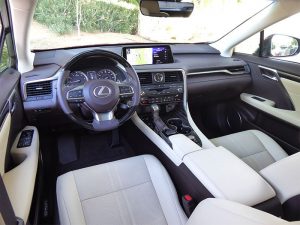
What Lexus tried to achieve here is a right-sized crossover. Not too small – but also not too big.
That third row isn’t the place to seat adults for more than short hops – but there is extra seating for kids and teens when it’s needed – without the extra length when it’s not.
One thing Lexus didn’t achieve – or rather, one thing which Lexus sacrificed to make this right-sizing work – is cargo capacity behind the third row, which is less than half that of the two-row RX (7.5 cubic feet vs. 18.4 cubic feet). However, if you fold the first and second rows down, you get slightly more total cargo capacity: 58.5 cubic feet vs. 56.3 in the two-row RX350.
You also get the adaptive suspension (AVS) with driver selectable modes that’s optional in the regular RX as part of the deal – and the option to buy quilted leather Rioja Red seat covers and matching trim for the steering wheel and shifter knob; these are not offered in the regular RX.
Or the longer-length RX 350L – which isn’t available with the F-sport stuff. It is, however, available with rear seat heaters and window shades and its own specific trim/color combinations. Either version can be ordered with the excellent 15-speaker Mark Levinson surround-sound audio rig, a heads-up display (HUD) and hands-free rear liftgate.
One thing you can’t get in either is a power upgrade. Even with the F-Sport cosmetic and suspension/handling enhancements, the V6 is the same as in the regular RX – though it’s made to sound a little tougher via artificially enhanced (through the stereo) intake roaring when you mash the gas pedal.
The RX has been a best-seller for Lexus in part because it got to market first – which gave it a running start. And in part because it’s a Lexus. It’s also a Lexus that’s based on what is arguably the best Toyota ever made – the Camry/Avalon (which is also the Lexus ES350).
These cars helped earn the company’s reputation for Blue Chipness, both in terms of reliability and their holding of value.
There are many other crossovers on the market now – so you have lots of choices. But many of the Johnny-come-latelys are worth less half their original sticker prices before you’ve finished paying off the loan. That won’t happen here – or at least, it hasn’t happened in the past. The RX holds its value better than any other crossover in its class – and that’s one very good reason to buy this crossover.
THE BOTTOM LINE
If you need a bit more crossover – but not too much crossover – Lexus has both for you.
…
Got a question about cars – or anything else? Click on the “ask Eric” link and send ’em in!
If you like what you’ve found here, please consider supporting EPautos.
We depend on you to keep the wheels turning!
Our donate button is here.
If you prefer not to use PayPal, our mailing address is:
EPautos
721 Hummingbird Lane SE
Copper Hill, VA 24079
PS: EPautos magnets are free to those who send in $20 or more. My latest eBook is also available for your favorite price – free! Click here. If you find it useful, consider contributing a couple of bucks! 


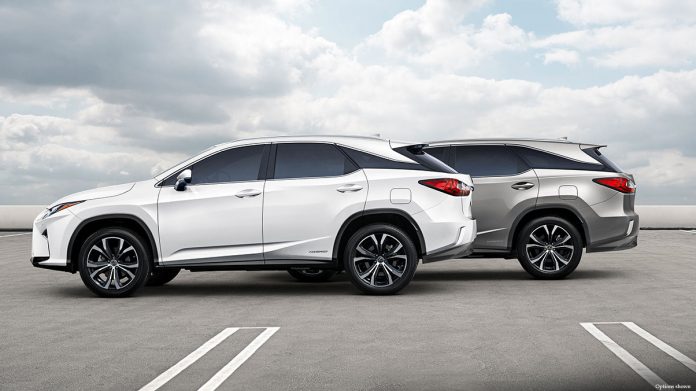

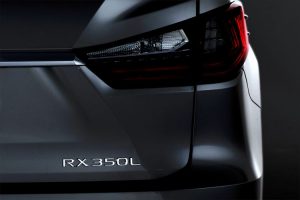
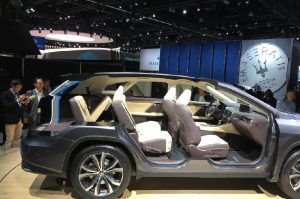
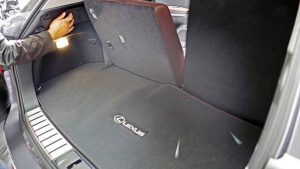

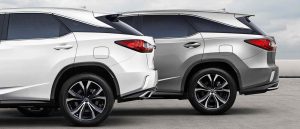
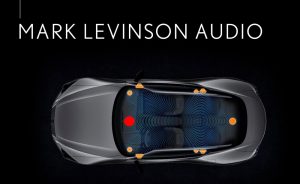









Here’s one more small entry to the “What’s Good” column. From a side view, the RX350 L is noticeably less hard to look at than the shorter version.
No worries though…..it’s still plenty ugly, for those who like this sort of thing. 😉
There’s no doubt that the 3rd row isn’t for full-size adults. The same applies to the third row in my GX470 – there’s no footwell to put your legs into, so only someone with short legs (like a kid) is going to be comfortable back there for longer than a lunch trip to the local sandwich place.
The Mark Levinson system is probably the best factory sound system out there (but .. I haven’t listened to the Burmeister system in the high-end Mercedes models yet). It’s a pricey option, but if you care about your music, and your local car audio shop guy breaks out in a sweat thinking about the computer integrations needed for an aftermarket stereo in modern cars, it’s worth it.
Hi Chip,
Agreed on the Mark Levinson – which in my opinion compares very well with the Burmester available in Mercedes’ models. But the best system I have experienced so far is the Meridian system used in Jags and Land Rovers…
I keep thinking about what I’d replace the GX with if it were to be totalled in an accident, or suffer an uneconomical repair bill. Probably a used diesel Jeep Grand Cherokee.
Hi Chip,
I am determined – if finances ever permit – to buy a full-size sedan/coupe from the late ’70s. I love the look – and the ride – and the fact these cars are V8 and RWD and I can fix anything that goes wrong myself. And for pocket change, relatively speaking.
Plus, you can flip over the air cleaner lid and then listen to the hiss of the four barrel…
Looks like a high-end Honda CRV, oh wait……which also looks like a Highlander, Escape, and the Subaru Crossover Thingy. They all look alike with slight variations in window shape or tail light or paint. Chevy had more distinctively different models in 1970 than all the car manufacturers do today. I watch them go by and come in the shop each day, and I can’t tell what brand they are unless I read it on the hood or tailgate, or hunchback, or whatever it is on the back of these grotesque gargoyles on 4 ghetto rims!
That’s it, they just look like Gotham City Crouching Gargoyles, ready to leap of the roof onto some unsuspecting “consumer”. Where is Raymond Lowey when you need him?
Hi Graves,
Raymond Lowey would be unable to find a job as a designer today; his stuff isn’t saaaaaaaaaaaaaaaaafe!
People are hot for crossovers, so I don’t harangue Lexus or any other company for making them. But part of the reason people are hot for them is because of market distortions created by the government, which have made normal cars – such as sedans – impractical and unappealing.
For example, there is no longer any such thing as a full-sized and modestly priced station wagon or large sedan with a huge trunk that can comfortably carry six people. So people are abandoning sedans and today’s smallish wagons in favor of… crossovers.
It doesn’t help that they have defacto banned 13 year old and under from even sitting in the front seat at all. Wouldn’t be able to do the car pools that my folks did for us kids back in the day, because there would be too many kids without the use of the front seat. God forbid they would have known about the one families van that had no seat belts (that would have resulted in a ticket had it been stopped even then).
The third row is a requirement for many families with more then two kids because the front seat is not in play anymore. That puts sedans in the no go for any family with little kids.
The powers that be never consider that, ever.
Morning, Rich!
That is an excellent point about the de facto ban on kids under 13 in the front seat. It’s obnoxious in the extreme – and I may have to write a full-length rant. The saaaaaaaaaaafety mandates force people like me – who have a regular cab truck – to buy some got-damned other vehicle that other people have decided on my behalf is saaaaaaaaaaaaaafer for my kids. If I had them. And I think one reason I don’t is exactly this sort of thing. I cannot abide it.
I actually broke up with a woman I’d been dating for awhile over seat belt use. I don’t wear them; she let it be known this annoyed her. She asked me one day whether I would wear them if “we had kids.” No, I said. And not only that, I would not “buckle up” “our kids” like little Hannibal Lectors, either. I’d even let them sit in my lap while I drove and such…
That was the end of that – thank the Motor Gods! 🙂
I get that it is your protest but unlike most things government forces seat belts really do work as I’ve learned by experience. I also find they help the handling the car because I put my effort to steering the car instead of holding myself in place. (I like accelerating on on-ramps so I am at speed for the merge.)
As to the kid stuff… remember why we have all these laws now is because government mandated airbags. Instead of admitting they messed up and the engineers at the automakers were correct they doubled down with more laws. For a decade and half or more they said the automakers were lying about airbags. Then the airbags were required and soon started killing short women and children. Just like those evil automakers said. A reason the evil automakers dropped the things from the option list. The unbelted male standard is deadly to people smaller than a certain size.
My kids ride on my lap all the time while driving. Just like me back in the 80’s.
Hi Graves,
Yes, all true. It looks as though panels interchange – especially side panels. The main difference, if any, is the shape of the grille. Vehicles are being homogenized, due to government interference – which (intentional or not) has also helped turn people off to them. They are becoming – have become – just appliances… all more or less alike. This is an important psychological building block toward getting people to accept – or at least, not object much – to the automated electric car.
The death of the American Car Culture is at hand, for sure. I would just as soon bleed from the rectum as to go spend my money on new, or even nearly new car or pickup.
Even car commercials these days are about as sexy and exciting as watching the government channel. At least the ads from the 70’s and 80’s used real cars and real people in a real environment. These retard “virtual ads” that have 90% CG have 0% believability, or charisma. At least in the ads prior to CG, the potential buyer could actually have a real expectation of being the happy or sexy or adventurous person in the ads. Now we know it’s all fakery and bullshit, so the new angle is to pit people against one another on the merits of Brand-Virtuosity. Jesus, the Puritans would have just loved this mind-fuckery being used on the public today. Come to think of it, isn’t that where most of our politicians with vast sums of money and immunity from everything come from, Puritan Hypocrite Hell, AKA New England?